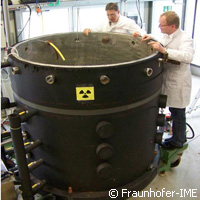Scientists develop test for residual pesticides from vegetable feed in farmed fish
A team of German scientists has shown that fish from fish farms are increasingly at risk from pesticide contamination due to the vegetable matter they are being fed. The finding comes as consumers are eating more fish today than ever before, with half of all this consumed fish coming from fish farms, making aquaculture a booming part of the global food industry with an annual growth rate of 9%. The team of scientists, from the Fraunhofer Institute for Molecular Biology and Applied Ecology (IME) in Schmallenberg, believe that to protect consumers, fish bred in captivity must be tested for pesticide residues, something as yet unrealised in the aquaculture industry - until now. This rise in demand for fish has had a knock-on effect on the demand for fish feed, with producers increasingly replacing hard-to-come-by feed ingredients such as fishmeal and fish oil with crops like soya, maize and rape. The team are worried that feed pellets made from these crops might contain pesticides. Although techniques known as metabolism studies are already used to test how the active ingredients in pesticides accumulate and break down in ruminants, poultry and pigs, these current techniques are not transferable to use with fish. The scientists therefore set out to create their own system, suitable for testing whether chemical substances accumulate in fish that are given contaminated feed. 'First, we test whether ingestion of the feed leads to a build-up of pesticide residues in fish tissue, and we look to see which degradation products or metabolites result from the fish's metabolic processes. Essentially, the more fat-soluble a substance is, the higher the probability of it accumulating in fish,' says Dr Christian Schlechtriem, from the Fraunhofer Institute. 'Our tests form the basis for later studies on feeding. The results determine whether these subsequent studies, which ascertain maximum pesticide residue levels, are required.' During the tests, the scientists put two freshwater fish frequently bred in farms, carp and rainbow trout, each weighing 300 to 500 grams, in water tanks that were 2 cubic metres in size. To detect and identify pesticide residues and their metabolites, the team added a radio-labelled test substance (a compound that has been joined with a radioactive substance) to the pellet feed. This was tricky for the team, as radio-labelled material is difficult to handle under aquatic conditions, but a powerful filtering system prevented the dissolved test substance from accumulating in the water. The researchers then tested the flesh of these fish for pesticide residues using highly sensitive analytical methods which can detect even the smallest quantities of a substance. Dr Dieter Hennecke, also from the Fraunhofer Institute, says: 'Our new test leaves no stone unturned in the search for pesticides and their degradation products in fish - from breeding through to tissue analysis in the laboratory.' This new fish test will soon be used by all producers and importers who want to bring a new pesticide onto the European market. Under new data requirements soon to be published by the European Commission, they will be obliged to register the pesticide and provide information that proves it won't build up in the edible parts of fish.For more information, please visit:Fraunhofer-Gesellschaft:http://www.fraunhofer.de/en.html
Countries
Germany



